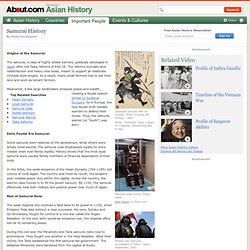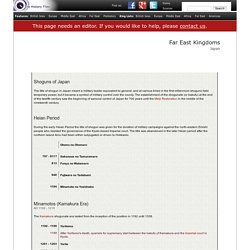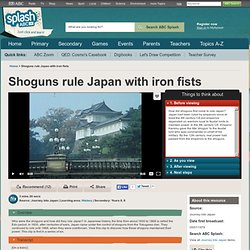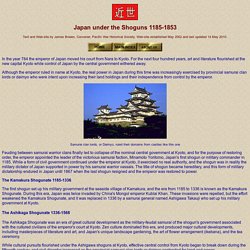

Code of the Legendary Samurai [FULL DOCUMENTARY] Definition of the term: Shogun. Samurai History in Japan. Origins of the Samurai: The samurai, a class of highly skilled warriors, gradually developed in Japan after the Taika reforms of 646 CE.

The reforms included land redistribution and heavy new taxes, meant to support an elaborate Chinese-style empire. As a result, many small farmers had to sell their land and work as tenant farmers. Meanwhile, a few large landholders amassed power and wealth, creating a feudal system similar to medieval Europe's. As in Europe, the new feudal lords needed warriors to defend their riches.
Early Feudal Era Samurai: Some samurai were relatives of the landowners, while others were simply hired swords. In the 900s, the weak emperors of the Heian Dynasty (794-1185) lost control of rural Japan. Rise of Samurai Rule: The weak imperial line received a fatal blow to its power in 1156, when Emperor Toba died without a clear successor. During this civil war, the Minamoto and Taira samurai clans rose to prominence.
Kamakura Period: In 1268, an external threat appeared. Feudaljapan. Simply Japan - Home. Tokugawa Period and Meiji Restoration - Facts & Summary. The Neo-Confucian theory that dominated Japan during the Tokugawa Period recognized only four social classes–warriors (samurai), artisans, farmers and merchants–and mobility between the four classes was officially prohibited.

With peace restored, many samurai became bureaucrats or took up a trade. At the same time, they were expected to maintain their warrior pride and military preparedness, which led to much frustration in their ranks. For their part, peasants (who made up 80 percent of the Japanese population) were forbidden from engaging in non-agricultural activities, thus ensuring consistent income for landowning authorities. Medieval Japan flashcards. World History Timeline Japan History 1648 AD. Shoguns of Japan Timeline. The arrival of a Dutch trading vessel, the Liefde, greatly unsettles the Portuguese and Spanish merchants in Japan.

The vessel's pilot, William Adams, is an Englishman of wit and charm. He is escorted to the powerful warlord, Tokugawa Ieyasu, where he reveals the lies peddled by Jesuits about religion in Europe. Ieyasu is no less interested in the Liefde's canon, and it is possible that he uses them in battle later in the year. (William Adams serves as the inspiration for the character of John Blackthorne in James Clavell's novel, Shogun, with the role played by Richard Chamberlain in the remarkable tv mini-series of the same name.) On 21 October 1600 the Battle of Sekigahara witnesses a mighty clash between more than 200,000 warlords, samurai, and retainers. However, Ieyasu is a shrewd operator. Shoguns and Art. Shoguns rule Japan with iron fists - History (8,9) - ABC Splash - Overview Who were the shoguns and how did they rule Japan?

In Japanese history, the time from about 1600 to 1868 is called the Edo period. In 1600, after centuries of wars, Japan came under the control of shoguns from the Tokugawa clan. They continued to rule until 1868, when they were overthrown. View this clip to discover how these shoguns maintained their power. 3 mins 20 secs Source: Journey into Japan | Learning area: History | Secondary: Years 8, 9 Transcript [On a train] [ ...Read more > British Musuem: Japanese samurai and shoguns. Japanese samurai and shoguns The Japanese word samurai means 'one who serves'.

Japan : History of Japan's Ancient and Modern Empire (Full Documentary) The Will of the Shogun. Japan Episode 3 [The Legacy of the Shoguns] Japan under the Shoguns. Japan under the Shoguns 1185-1853 Text and Web-site by James Bowen, Convener, Pacific War Historical Society.

Web-site established May 2002 and last updated 14 May 2010. In the year 784 the emperor of Japan moved his court from Nara to Kyoto. For the next four hundred years, art and literature flourished at the new capital Kyoto while control of Japan by the central government withered away. Although the emperor ruled in name at Kyoto, the real power in Japan during this time was increasingly exercised by provincial samurai clan lords or daimyo who were intent upon increasing their land holdings and their independence from control by the emperor.
Samurai clan lords, or Daimyo, ruled their domains from castles like this one.